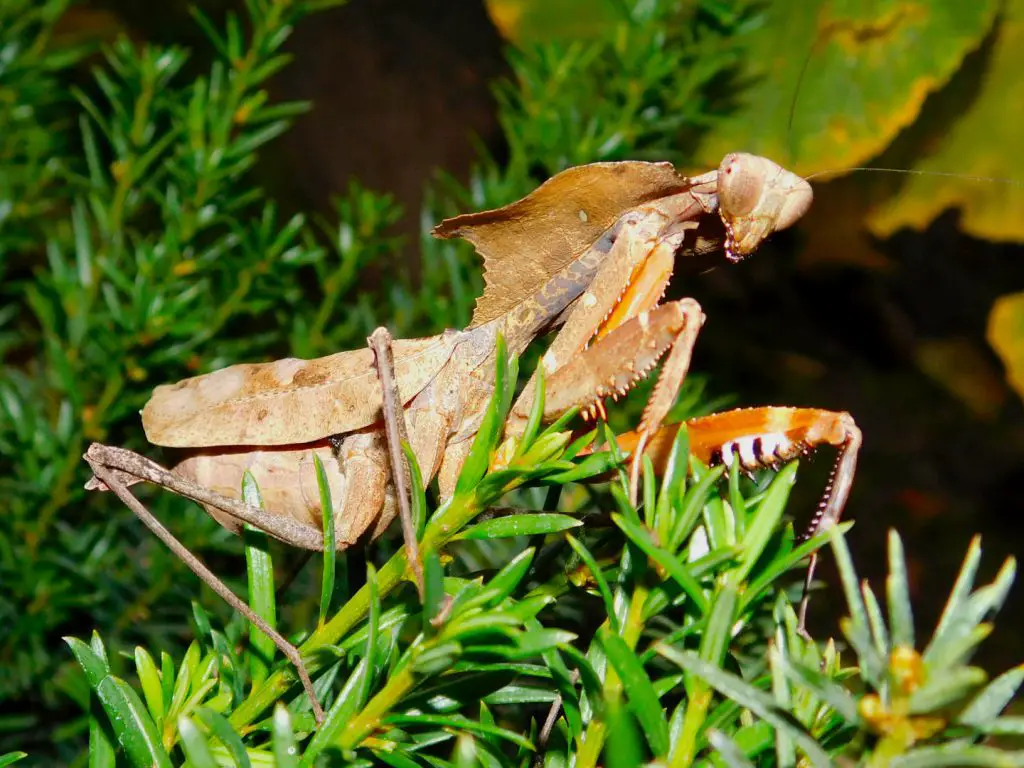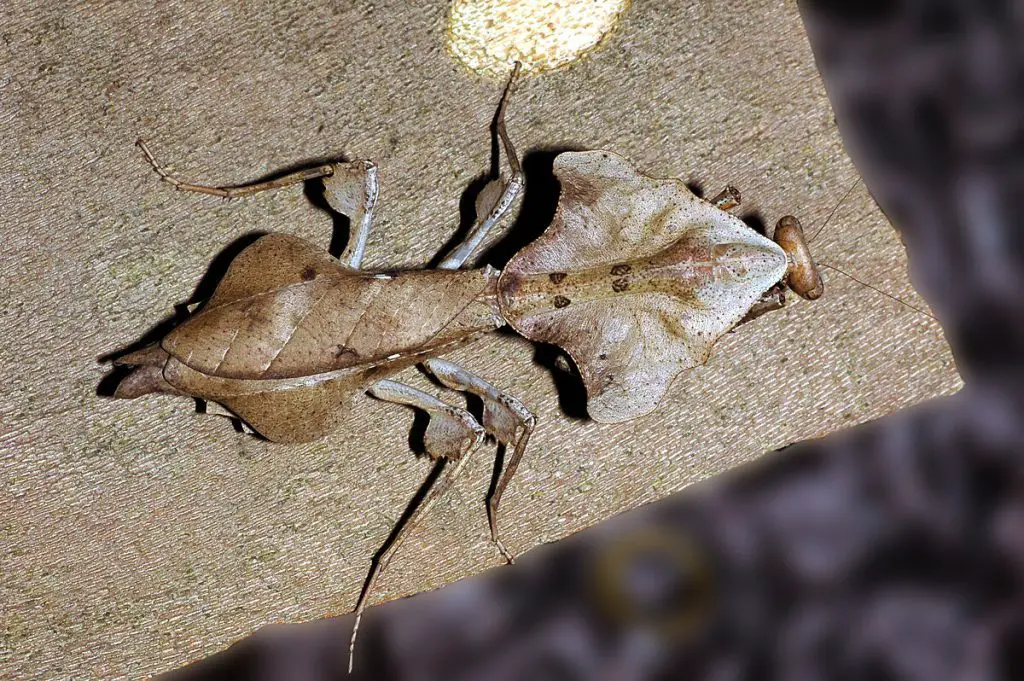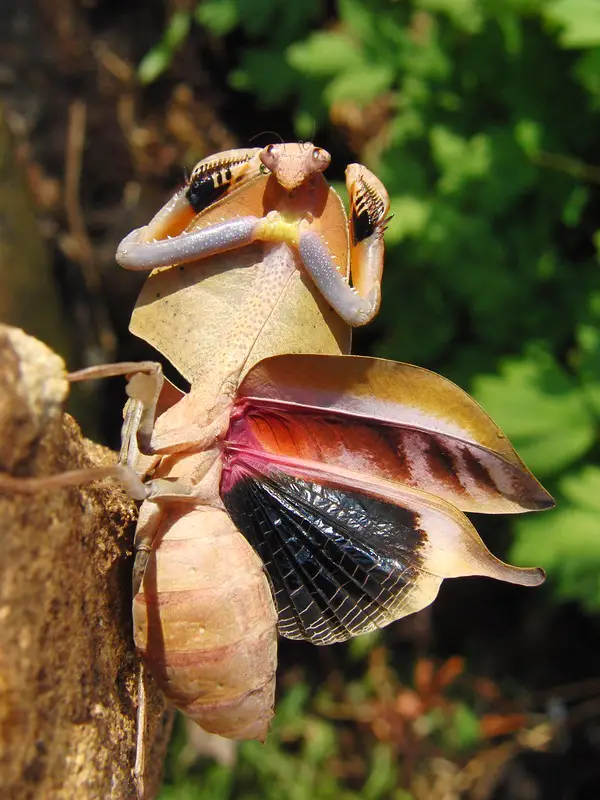Deroplatys is a fascinating group of mantids known for their leaf-imitating abilities. They are commonly referred to as “Dead Leaf Mantis” due to their exceptional camouflage that mimics dead leaves in the forest floor. Deroplatys mantids are primarily found in the rainforests of East Asia.

Physical Appearance
Dead Leaf Mantis exhibit a middle to large size, with the males typically measuring around 6.5 to 7 cm, and the females being slightly larger at 7.5 to 8 cm. These mantids come in various shades of brown, from light to dark, providing them with versatility in matching their surroundings. The most striking feature is their large pronotum, which resembles the shape of a leaf, further enhancing their camouflage. This adaptation allows them to hide from predators and stealthily ambush their prey.
Geographic Distribution
Deroplatys mantids are predominantly found in the rainforests of East-Asia. They are distributed across various regions, including the Malaysian Peninsula, Sumatra, Java, Borneo, Thailand, and New-Guinea. Their preferred habitat comprises grounds covered with dead leaves, bushes, and other debris. These mantids inhabit damp areas within the tropical rainforest, where they can effectively utilize their leaf-like appearance to avoid detection and hunt for their prey. The rich biodiversity of East-Asia provides them with a diverse range of potential food sources and hiding spots, enabling them to thrive in this lush environment.
Keeping Dead Leaf Mantis
Suitability for Keeping
Keeping Dead Leaf Mantises can be a rewarding but challenging endeavor. Their leaf-imitating nature and unique requirements make them more suitable for experienced mantis keepers rather than beginners. Providing the right conditions, such as appropriate lighting, temperature, and humidity, can be demanding. Additionally, their aggressive behavior towards each other, especially among older female nymphs and adult females, necessitates careful consideration when housing them together.
Terrarium Setup
For single keeping, a spacious terrarium with dimensions of at least 20cm x 20cm x 30cm is recommended. This size allows the mantises to have ample space for movement and provides areas for proper camouflage. The terrarium should be equipped with branches, plants, twigs, leaf litter, and roots to create a natural environment that mimics their rainforest habitat. Earth-sand-mixture substrate, with a depth of about 5cm to 10cm, can be used to ensure a comfortable and secure environment for molting.
Recommended Lighting, Temperature, and Humidity Levels
Deroplatys mantises require appropriate lighting that replicates natural daylight, but it should not be too bright. Halogen lamps or other suitable lightning can be used to maintain a day length of approximately 12 hours. The daytime temperature should range between 25°C to 30°C, while the night temperature should not drop below 20°C to keep them warm and healthy. Maintaining a humidity level of 60% to 80% during the day and 70% to 90% during the night is essential to support proper molting and hydration.
Preferred Food Sources
The diet of Dead Leaf Mantises primarily consists of live prey. Drosophila flies, moths, cockroaches, and small crickets are among their preferred food sources. Providing a varied and nutritious diet is essential for their growth and development. Keepers should offer prey that matches the mantises’ size, ensuring they have an adequate food supply to sustain their energy levels.

Nymph Development and Lifecycle
Typical Nymph Appearance
The nymphs of Deroplatys mantises display leaf-imitating characteristics from early stages. As they progress through their development, they resemble larger nymphs, but they do not exhibit ant-mimicry like some other mantis species. Their body shape and coloration are adapted to blend in with the dead leaves and twigs of their rainforest habitat, providing them with effective camouflage against potential predators.
Lifespan
The lifespan of Deroplatys mantises varies between males and females. Males generally have a shorter lifespan compared to females. Male mantises live for approximately 9 months, which includes about 7 moltings throughout their growth. On the other hand, female mantises have a longer lifespan, surviving for around 14 months, undergoing about 9 moltings during their development. These molting stages are significant milestones in their growth, allowing them to shed their skin and continue to grow in size.
Sexing
Sexing Deroplatys mantises can be accomplished using certain characteristics specific to each gender. For male nymphs from the L4 stage and above, their pronotum assumes a spearhead shape. In contrast, female nymphs of the same stage display a “M” shaped pronotum. At the adult stage, male mantises retain their thin body shape, while females have a thicker abdomen that resembles a “Delta” shape.
Other metod is to simply count thier abdominal segments. You can read more about sexing in our article about differences in males and females.

Mating
Readiness for Copulation
Male and female Deroplatys mantises, including Deroplatys desiccata, Deroplatys lobata, and Deroplatys truncata, exhibit copulation readiness approximately three to four weeks after their last molt. During this period, they undergo physical and behavioral changes, becoming more active and responsive to potential mates. Both males and females become more receptive to copulation cues, and their bodies mature to enable successful mating.
Copulation Duration
The copulation duration for all three species of Deroplatys mantises typically lasts approximately 10 to 20 hours. During this time, the male initiates the mating process by approaching the female cautiously. The male often engages in courtship behavior, which may involve gentle touching or tapping of the female’s body. The female can exhibit either acceptance or rejection cues during this stage. If accepted, copulation occurs, and the male transfers his spermatophore to the female’s reproductive tract.
Throughout the copulation, both male and female mantises remain stationary, forming the distinctive “T” shape frequently observed in mantis mating. After the mating process is complete, the male carefully disengages and separates from the female to avoid any potential aggressive response.
Oothecae
Ootheca formation for Deroplatys mantises occurs within 5 to 9 weeks after the female’s last molt. The female will find a suitable location and begin constructing the ootheca by secreting a frothy substance that hardens to protect the developing eggs. The ootheca is then filled with a cluster of eggs, and the female guards it vigilantly to ensure its safety.
The appearance of the ootheca is similar among all three species within the Deroplatys genus. It is cylindrical, long, and slightly bent, resembling a miniature seedpod or a dried leaf. The coloration is typically grayish-red-brown, blending in with the natural environment, which aids in camouflage and protection from potential predators.
Hatching
Number and Appearance
From a single ootheca, Deroplatys mantises can yield up to 63 hatchlings, with an average of around 30 offspring. These tiny nymphs emerge from the ootheca and are approximately 12mm in size. They exhibit a remarkable resemblance to their adult counterparts, with a big pronotum and leaf-like appearance, allowing them to blend into their natural environment effectively.
Hatching conditions
To ensure successful hatching, maintaining appropriate temperature and humidity levels is crucial. For Deroplatys mantises, including Deroplatys desiccata, Deroplatys lobata, and Deroplatys truncata, the incubation temperature should be kept between 25°C to 30°C. It is essential to provide humidity levels of 80% to 100% during incubation. Regularly spraying the ootheca with water every day helps maintain the necessary humidity for the eggs to develop and hatch successfully.

Conclusion
In conclusion, the genus Deroplatys comprises leaf-imitating mantises, commonly known as Dead Leaf Mantis. They are middle to big-sized mantids with a distinctive large pronotum, allowing them to mimic dead leaves effectively. At least 11 species have been described, including Deroplatys desiccata, Deroplatys lobata, and Deroplatys truncata, primarily found in East Asia, particularly the Malaysian Peninsula, Sumatra, Java, Borneo, Thailand, and New Guinea.
These mantids present unique challenges for keeping and breeding, as they have specific requirements concerning lighting, temperature, and humidity that need to be met for their well-being. They are best kept separately due to high aggression, especially among older female nymphs and adult females. The nymph development and lifecycle involve multiple molting stages until reaching adulthood, with males typically living for about nine months and females up to 14 months.